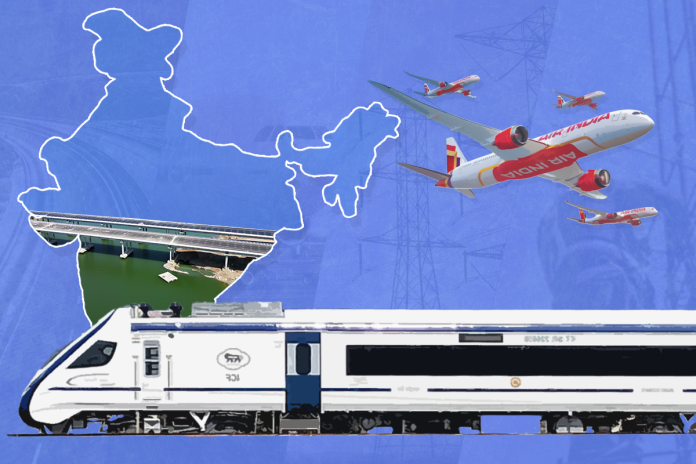The year 2023 has been pivotal for Indian infrastructure.
For this current fiscal year, the union government had significantly upped its infrastructure-related spending to 3.3 per cent of GDP, a nearly threefold increase from its 2019-20 expenditure.
With the economy having fully recovered from Covid-19-related disruptions, the focus has been on execution and delivery. Here’s a quick summary.
Railways
With a capital budget allocation of over Rs 2 lakh crore, Indian railways has been able to do both long gestation and short turnaround projects.
First, Indian railways managed to launch 26 new Vande Bharat routes this year, taking the total Vande Bharat service routes to 34.
These new trains now cover 12,000 km across 24 states.
Second, India also launched its first Rapid Rail Transit System (RRTS), albeit a limited 17-kilometre section of a much longer Delhi-Meerut line (82km). This line is set to be completed in 2025 and has been funded to the tune of just above Rs 30,000 crore.
Third, 2,513 km of the dedicated freight corridors have been completed so far, with trains already hauling freight over completed sections. The dedicated freight corridor project now stands at 88 per cent of completion.
Fourth, the Amrit Bharat Station Redevelopment scheme was launched. Separately, large projects such as the redevelopment of Mumbai’s Chhatrapati Shivaji Maharaj Terminus (CSMT) have also received significant impetus.
Aviation
In the last 12 months, four new airports and four new terminals have opened marking an increase to a total of 149 operational civil airports — twice the count from a decade ago.
The newly opened and revamped ones include Mopa International Airport in Goa, Hirasar Airport near Rajkot, Veer Savarkar Airport in Port Blair, and the Tezu Airport in Arunachal Pradesh. Bengaluru Airport’s Terminal-2 received rave reviews from travelers following its inauguration this year.
The sector also saw a string of developments.
First, between Indian airline operators nearly 900 aircrafts have been ordered Air India placed an order for 470 aircraft while IndiGo has ordered 500 A320 aircraft – the deals were announced at the Paris Air Show.
Second, much of the growth is attributed to the UDAN (Ude Desh ka Aam Nagrik) scheme initiated in 2016. The scheme received Rs 1244 crore this fiscal year.
Third, in terms of upcoming airports – Ayodhya Airport is set to be inaugurated before the year ends and further two airports — in Noida and Navi Mumbai are expected to begin limited operations next year.
Lastly, work on greenfield projects such as the new airport in Parundur in Chennai are beginning to gather pace.
India’s Metro Systems
India’s metro systems will soon overtake USA’s systems in terms of length of service lines. Here are some notable numbers on the metro ecosystem.
First, the allocation for metro systems stands at a total of Rs 19,518 crore to all metro projects across India in 2023-24.
Second, Bengaluru Metro works have progressed well in the first half of the year. The city network’s purple line (43.49km long) was completed this year – allowing nearly 2.8 lakh passengers to take the metro to work daily.
Third, Mumbai’s metro network saw Line-2A and Line-7 inaugurated this year, making three lines operational in the Mumbai Metro. With Navi Mumbai Metro Line also operational, the city is beginning to see active metro service adoption.
Third, Pune also saw advancements with two new sections of the Purple Line and Aqua Line becoming operational in August. This opened approximately 24 km of the 33 km network for public use.
Lastly, Bhopal and Indore have also seen successful trial runs of their metro lines and are expected to launch services in 2024.
India’s currently operational metro network is around 851 km and by the end of 2024, it will have over 1,100 km of operational metro lines.
India, however, remains far behind China, which claims to have operationalised a metro network of 9,000 km in its cities – Shanghai alone accounts for 800+ km.
Expressways
The Ministry of Transport and Highways (MoRTH) has remained active throughout the year with several expressway segments coming online.
Here’s a quick review.
First, the Delhi-Mumbai Expressway — is set to be India’s longest expressway spanning 1,386 km upon completion. Two segments of this expressway were inaugurated this year, each measuring a little more than 240 km in Rajasthan and Madhya Pradesh respectively.
Second, the Bengaluru – Mysuru expressway (118km) was thrown open reducing the time taken between the cities to just about 75 minutes from 3 hours.
Third, the second phase of the Mumbai – Nagpur Samruddhi Mahamarg, making a total of 600 km out of the 701 km of the expressway, was also open to the public this year.
Lastly, MoRTH has said that it has constructed 4,474 km of national highways up to October in 2023-24 as against 4,060km in the same period last year.
By the end of the fiscal year, the ministry aims to complete 12,500 km of national highways. The numbers for the previous years are 10,237 km of National Highways in 2019-20, 13,327 km in 2020-21 and 10,457 km in 2021-22.


